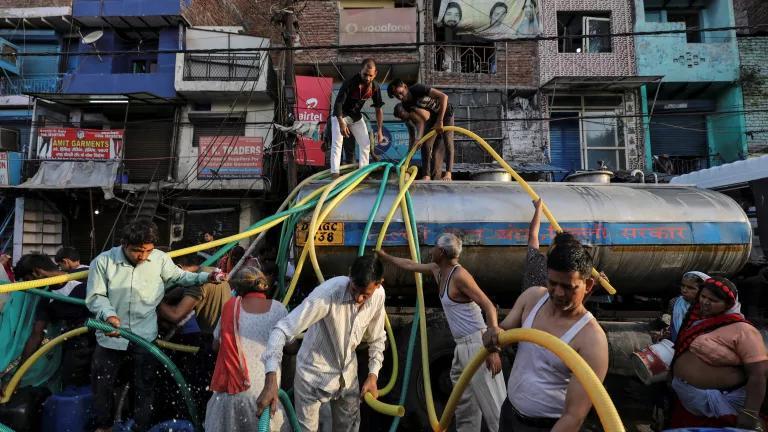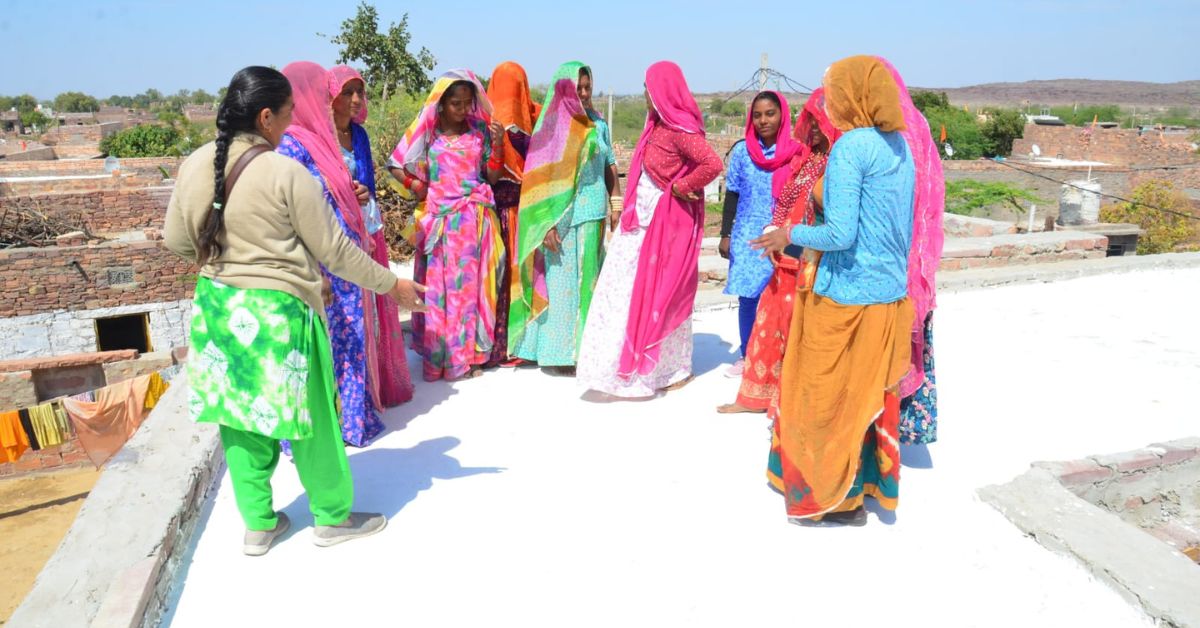With summer at its peak, parts of north and east India are still experiencing extreme heat while other regions begin to cool down with the rains. In some states, temperatures have crossed 47°C, making daily life challenging. From health risks to parched roads, the heat has become a pressing concern—but communities and individuals are finding ways to adapt and stay safe.
According to the Heat Watch 2024 report, 733 deaths due to heatstroke were recorded across 17 states between March and June last year. Additionally, the Indian Meteorological Department has warned that several states like Bihar, Uttar Pradesh, and Madhya Pradesh will experience more heatwave days than usual this year.
While some people escape to the hills in search of cooler climes, and others retreat indoors with the air conditioning on full blast, a growing number are taking a different approach.

1. Turning Tin Roofs Into Heat Shields
Where: Kishan Kunj, East Delhi
Who: Residents and SEEDS (Sustainable Environment and Ecological Development Society)
What they did: In the tightly packed lanes of Kishan Kunj, a low-income settlement in East Delhi, the summer sun turns metal roofs into baking trays. Most homes have tin sheet roofs that trap heat, making it unbearable inside.
To tackle this, the NGO SEEDS launched the “Under the Umbrella” campaign, distributing aluminium bubble insulation sheets to households. These silver sheets, when installed under the tin roofs, act as a barrier, reflecting heat and significantly lowering indoor temperatures. It’s a simple idea with a big impact — families now report a noticeable drop in how hot their homes get during the day.
What drove this change: Staying indoors no longer feels like being in an oven. For families who can’t afford air conditioning, this solution provides comfort, health, and safety.
Bring it to your community: If you live in an area with similar roofing, explore heat-reflective materials like aluminium sheets or white paint. NGOs like SEEDS often offer community-based training and resources you can tap into.
2. Set up a pyau (cooling stations) for workers
Where: Neighbourhoods around Delhi and Gurgaon
Who: The Residents Association
What they did: While many find respite indoors with the comfort of air conditioning, daily workers such as delivery workers, rickshaw pullers, security guards, and street vendors have no choice but to work under the scorching sun every day.
As a great example of how adversity brings us together as human beings, the residents came together offering bowls of kindness. They set up small cooling stations often referred to as pyau in the local language, at their society gates, local markets, and street corners. Resident Welfare Associations took the lead, placing earthen pots (matkas) filled with water or homemade summer coolers like shikanji, sattu, or thandai for passersby.
Some families went a step further, offering kacchi lassi or Oral Rehydration Solution packets directly from their balconies. A few corners now even have battery-powered fans, wet khus mats, or sprinklers, offering a moment of shade and relief to anyone walking past.
What drove this change: The brutal heat outdoors is more than uncomfortable; it’s hazardous for daily workers who are exposed to the sun constantly. Even though this solution seemed simple, it made a big impact on the lives of these workers.

Bring it to your community: You don’t need a massive setup — just a matka, a table, and a bit of coordination with your neighbours. Choose a spot that gets decent footfall, like the society gate, near guard booths, or by a local vendor’s cart. Refill the pot with clean, cool water a couple of times a day, and consider rotating shifts with other residents. Add a sign that says “Free for all” in simple language, and maybe place a dustbin nearby to keep things tidy.
3. Solar Reflective “Cool” Roofs in Ahmedabad Slums
Where: Ahmedabad slums
Who: Mahila Housing Trust
What they did: During the middle of the day when the sun is right above their heads, the flimsy roofs of the slum houses increase the temperatures to unbearable limits. They absorb heat, making the experience of staying indoors more excruciating than being outdoors. This is because of the poor ventilation, which makes sure the heat gets trapped inside.

The Mahila Housing Trust came up with a creative hack of painting them with solar-reflective white paint, giving them a cool yet practical makeover. A fibre sheet was used for the roof, and was placed in a dome style with a jaali structure for ventilation.
What drove this change: For slum dwellers who share walls with their neighbours, good ventilation is a distant dream. This simple, effective solution made the option of staying indoors a viable option for shielding themselves from the heat.
Bring it to your community: A bucket full of white paint, brushes and determination is all you need to execute this simple act that makes a big difference.
4. Mini Forests in Faridabad Using the Miyawaki Method
Where: Faridabad
Who: Faridabad Summer Palm Society
What they did: The residents of the Faridabad Palm Society were fed up with short-term tips and tricks. They decided to come together to invest in a solution that could prevent the problem from getting worse — they turned their housing complex into a mini forest.
They planted around 1200 native plants, including neem and peepal, across 500 yards, around 4 years ago. They used the Japanese Miyawaki method.

Miyawaki technique: This is a method of rapidly creating dense, native forests in small urban or rural spaces. Developed by Japanese botanist Dr Akira Miyawaki, it involves planting a mix of native tree and shrub species very close together, which encourages faster growth and dense vegetation. It mimics natural forest ecosystems and typically results in a self-sustaining, biodiverse green space within two to three years — 10 times faster and 30 times denser than traditional afforestation methods.
What drove this change: This act is a commitment to a better future. Their effort from four years ago has created a forest-like environment in urban areas. It improved air quality along with the scenery.
Bring it to your community: This method requires small patches of land and comparatively much reduced effort when it comes to bringing back lost green cover. Native species of plants are grown together in a small space. With the help of a few more hands from the neighborhood, this can be an effective solution for a faster and greener tomorrow.
5. Solar-powered cooling stations for slum residents
Where: Jodhpur, Rajasthan
Who: Local communities, supported by Natural Resources Defense Council (NRDC) and partners
What they did: Jodhpur, infamous for its extreme summer heat, often records temperatures above 45 degrees Celsius. For residents in low-income settlements, this isn’t just uncomfortable — it’s dangerous. As part of the city’s Heat Action Plan, solar-powered cooling stations were set up in densely populated areas to offer people a much-needed break from the relentless heat.
These portable cooling stations come with solar panels, mist fans, and natural features like grass roofs to cool the area. The design is simple but smart. They can be relocated depending on the heat risk, like shifting them near bus stops, markets, or crowded colonies. Women and youth volunteers manage these stations, helping locals stay hydrated and informed.
What drove this change: These hubs bring the temperature down in real-time and create a space where people can safely cool off. They’ve also helped reduce incidents of heatstroke and fainting. It’s low-cost, sustainable, and most importantly, community-run — making it a model that’s both practical and empowering.
Bring it to your community: If you live in a heat-prone area, start by identifying high-risk zones like places with poor ventilation, no shade, and lots of foot traffic. Partner with local non-governmental organisations, urban planners, or municipal authorities to build small stations with solar-powered fans or even basic mist setups. Use affordable, eco-friendly materials like bamboo, cloth, or grass roofing for shade. Get youth groups or local volunteers involved in managing and maintaining them. You don’t need huge funds to get started. Just a solid plan and a few committed people can bring serious relief to your neighbourhood.
Edited by Saumya Singh and Leila Badyari
##QA-TP1##
No comments:
Post a Comment